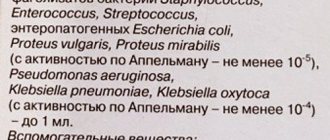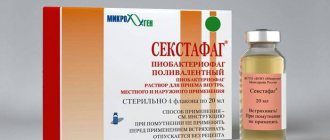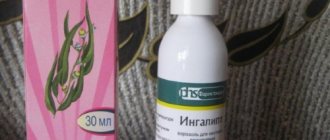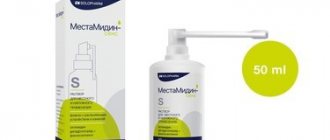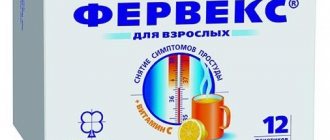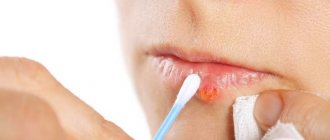Indications for use
- intestinal purulent-inflammatory processes;
- corneal ulcers , keratoconjunctivitis , conjunctivitis ;
- cystitis, colpitis, pyelonephritis;
- otitis, sinusitis, pleurisy, pneumonia, sore throat, pharyngitis;
- mastitis, abscesses, hydroadenitis, various carbuncles and boils, burns, suppuration of postoperative wounds.
Pyobacteriophage complex
The drug is used orally, rectally, locally, or by injection into cavities. Orally: enterocolitis, diseases of internal organs, intestinal dysbiosis - 3 times a day 1 hour before meals. For 1 dose up to 6 months - 5 ml, 6-12 months - 10 ml, from 1 to 3 years - 15 ml, from 3 to 8 years - 20 ml, from 8 years and older - 30 ml.
Rectally 1 time per day (in the form of an enema) in combination with twice oral administration. For 1 dose up to 6 months - 10 ml; 6-12 months - 20 ml; from 1 year to 3 years - 30 ml; from 3 to 8 years - 40 ml; from 8 years and older in an enema - 50 ml.
Locally for 7-20 days in the treatment of purulent-inflammatory diseases with localized lesions.
If the cavity of a purulent lesion is treated with chemical antiseptics, before using the bacteriophage, rinse the cavity with a sterile 0.9% NaCl solution.
Purulent wounds - in the form of irrigation, applications, bandages, administration through drainage at least 1 time per day. For abscesses, after opening and removing the purulent contents, the drug is administered in an amount less than the volume of the removed pus. In drained cavities daily, 1 time per day - 20-200 ml.
Osteomyelitis - 10-20 ml into the wound cavity through the turunda, drainage.
Introduction into cavities (pleural, articular and other limited cavities) - up to 100 ml of bacteriophage, leaving capillary drainage through which the bacteriophage is reintroduced over several days.
Purulent-inflammatory gynecological diseases - 5-10 ml daily 1 time per day into the cavity of the vagina, uterus.
Purulent-inflammatory diseases of the ENT organs - 2-10 ml 1-3 times a day in the cavity of the middle ear, nose. The bacteriophage is used for rinsing, washing, instilling, and introducing moistened turundas (leaving them for 1 hour).
Cystitis, pyelonephritis, urethritis - 20-50 ml into the bladder and 5-7 ml into the renal pelvis through a cystostomy or nephrostomy.
Children under 6 months. Sepsis, enterocolitis in newborns, including premature babies, 2-3 times a day in the form of high enemas (through a gas tube or catheter). In the absence of vomiting and regurgitation, the drug is used orally, mixed with breast milk. A combination of rectal and oral administration of the drug is possible. The course of treatment is 5-15 days; in case of recurrent course of the disease, repeated courses of treatment are possible. To prevent sepsis and enterocolitis during intrauterine infection or the risk of nosocomial infection in newborns, the bacteriophage is used in the form of enemas 2 times a day for 5-7 days.
Omphalitis, pyoderma, infected wounds - 2 times a day daily in the form of an application (moisten a gauze cloth with bacteriophage and apply to the umbilical wound or affected area of skin).
Analogs
Level 4 ATC code matches: Cystamine
Neovasculgen
Plantain juice
Acizol
Leucovorin
Lymphomyosot
Sodium thiosulfate
Galium-Hel
Dicarbamine
Spascuprel
Methylene Blue
Ammonia
Mucosa Compositum
Coenzyme Compositum
Ubiquinone Compositum
Dimephosphone
Unithiol
Naloxone
Oscillococcinum
Intesti-Bacteriophage
Typhoid Bacteriophage, Dysentery Bacteriophage, Klebsiella Polyvalent Bacteriophage, Coli Bacteriophage, Proteophage, Intesti-Bacteriophage, Combined Pyobacteriophage, Sextaphage , Polyvalent Pyobacteriophage .
Release form and composition
The product is available in the form of a solution for oral, local and external use; is a transparent yellow liquid of varying color intensity, may have a greenish tint (20 ml bottles, 8 bottles in a cardboard box; 100 ml bottles, 1 bottle in a cardboard box).
Active substance in 1 ml of solution: sterile purified filtrates of phagolysates of bacteria Streptococcus, Enterococcus, Staphylococcus, enteropathogenic Escherichia coli, Proteus mirabilis and Proteus vulgaris (with an activity of at least 10-5 according to Appelman), Klebsiella pneumoniae, Pseudomonas aeruginosa and Klebsiella oxytoca (with activity of at least 10-4 according to Appelman) – up to 1 ml.
A preservative is used as an auxiliary component: 8-hydroxyquinoline sulfate (0.0001 g/ml) or 8-hydroxyquinoline sulfate monohydrate (0.0001 g/ml in terms of 8-hydroxyquinoline sulfate).
Pharmacological properties
The word “bacteriophage” translated from Greek means “destruction of bacteria.” In modern medicine, this term refers to a family of individual viruses that can affect certain representatives of the microflora. In the treatment of infectious diseases, phages are used that live in the habitat familiar to humans (in water, soil, on the surfaces of objects).
The therapeutic properties of bacteriophages allow them to compete with antibacterial drugs.
Compared to antibiotics, Pyobacteriophage:
- has a targeted effect, destroying exclusively the causative agent of the disease, and not the beneficial microflora;
- does not suppress the immune system;
- demonstrates good results in the treatment of indolent protracted diseases of bacterial etiology with high resistance.
The bacteriophages used in the manufacture of this drug are essentially parasites. Viruses invade a microbial cell and use its structures and reserves for their own growth, nutrition, and reproduction. Interestingly, each bacteriophage has exclusively genetic material coated with a protein coat.
Each type of bacteriophage affects certain bacteria, therefore the Pyobacteriophage contains phagolysates of several strains. Thanks to this, the drug is effective against various pathogens.
Pyobacteriophage complex, reviews of which are controversial, can be used in combination with antibiotics and is not addictive.
Contraindications
There are no absolute prohibitions on the use of this bioactive medicine. The drug Piobacteriophage should not be used only in case of individual intolerance to the substances it contains.
Restrictions on the use of the drug during pregnancy and lactation can be considered relative. Before using this product, you must consult a doctor to determine the exact dosage and duration of therapy, as well as undergo a detailed examination to identify the infectious pathogen.
Side effects
There is insufficient information about confirmed cases of adverse reactions. It is known that the drug extremely rarely causes symptoms of individual intolerance. Moreover, an allergy can be triggered by any of the components in the product. Patients who are not suitable for Pyobacteriophage may experience nausea, dizziness, and weakness.
The likelihood of side effects occurring is higher for those users who neglect the rules or shelf life of the medicine, or ignore the manufacturer’s recommendations in the instructions for use.
special instructions
An important condition for the effectiveness of therapy is the prior determination of the phage sensitivity of the pathogen and the early use of Pyobacteriophage complex.
Before each use, the bottle of solution must be shaken and inspected for any turbidity.
The nutrient medium contained in the drug is well suited for the development of bacteria that have entered the vial from the environment, and they can cause turbidity of the solution. To avoid this, when opening the bottle, it is recommended to adhere to the following rules:
- Wash your hands thoroughly.
- Treat the cap with an alcohol solution.
- Without opening the stopper, remove the protective cap from it.
- If the cork opens, do not place it inside on the table or other surfaces.
- Do not leave the bottle open.
After opening, store the bottle only in the refrigerator.
Extraction of the solution in the required volume from the bottle should be done using a sterile syringe by piercing the stopper.
After opening the bottle, subject to the recommended storage conditions, as well as in the absence of visible turbidity, the drug can be used throughout the shelf life.
Pyobacteriophage complex is unsuitable for use if the solution becomes cloudy, the integrity of the bottle or labeling is damaged, or after the expiration date indicated on the bottle.
Impact on the ability to drive vehicles and complex mechanisms
Information is absent.
Drug interactions
Most bacteriophages can be used in combination with antibacterial medications. Researchers have been able to prove that phages effectively enhance the effect of antimicrobial agents, provided that the pathogen is correctly identified.
If Pyobacteriophage is used externally after antiseptics of chemical origin, between these drugs and the bacteriophage it is necessary to wash the wound with a regular 0.9% saline solution. Treatment with viruses does not eliminate the need to use traditional antibacterial compounds.
There is minimal information about the effect of ethyl alcohol on the properties of the drug, since studies of this kind have simply not been conducted. However, to be confident in the results of treatment, doctors advise stopping drinking alcoholic beverages for a while.
By the way, alcohol is not compatible with most modern antibacterial substances used in the complex treatment of infections.
Overdose
Pyobacteriophage complex, reviews of which are studied by most patients on the eve of treatment, is not dangerous if the dosage prescribed by the doctor is exceeded. This drug does not have a negative effect on human health. There is no information about changes in condition due to excessive consumption of the drug in the annotation.
Pyobacteriophage complex
However, adherence to accurate dosage calculations will save your budget. With intensive use, the consumption of the drug increases, which means that in cases where 1 package would be enough, you will have to purchase another one. Considering the low cost of the bacteriophage, an additional purchase may disrupt existing plans.
